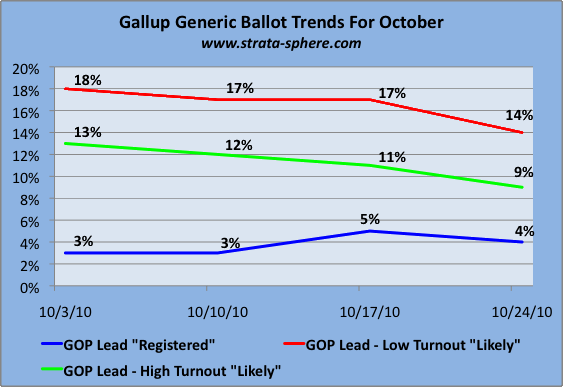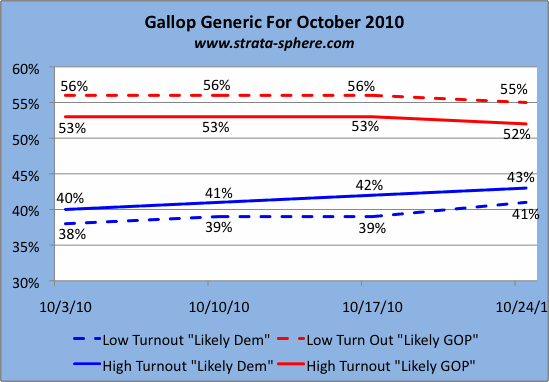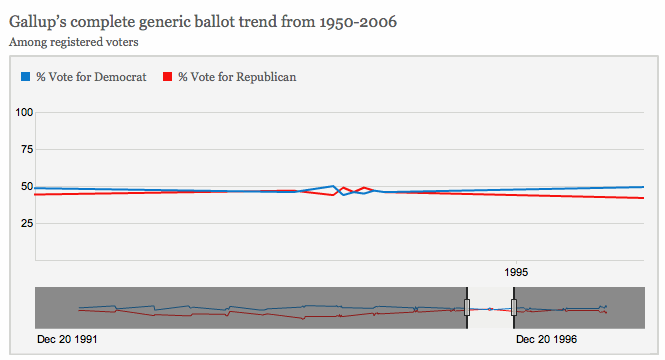Oct 25 2010
Gallup Generic Shows Slight Tightening – Enthusiasm Chasm Still There
Major Updates Below!
Here is a quick post on the Gallup Generic Ballot numbers just out (click to enlarge). The latest numbers show a slight tightening in the “likely” voter models, but nothing that could save the Democrats at this juncture. Assuming there is still a 2-3% underestimation in the Gallup numbers verses the final results (something Gallup themselves admit happens) the wave is still out there. Add in the GOP lead with independents and lots of Dems will be forced into retirement come next Tuesday. More tomorrow!
Update: As promised, more on the latest Gallup Generic Ballot results. Gallup has decided to provide two ‘likely voter’ turnout models in order to cover the scenario where this year’s election draws more voters than the typical midterm. What this means is we get a range of possible GOP and Democrat performance on the generic ballot within which there is a high probability the November elections could fall.
This expected range is shown in the following diagram, where the solid interior lines represent the high turnout scenario, and the dashed lines show the low turn out scenario. Reality will probably fall between the dashed and solid lines for each party (not accounting for statistical errors, which could expand these ranges even more). Click to enlarge.
Jim Geraghty points out that, while there is some tightening, we are nowhere near the 1994 levels where the Democrats took a historic beating and lost 52 seats.
… in October 1994, the generic ballot split, 47-47.
I took a snapshot of the 1992-1994 Gallup data and it shows something quite interesting:
It’s hard to see the detail, but what is clear is that in good years the GOP simply gains parity with the Dems and never goes above 50% – until this year. This year is different from any other year in Gallup’s long history of polling. That is why so many people are simply awestruck in their inability to determine where this election is heading.
This actually makes perfect sense to anyone who is not a liberal in deep denial. The key differences this year as opposed to 1994 are: (1) a horrific economy and unemployment situation that did not respond to failed government spending, (2) a frightening $3 trillion dollars in debt piled up in 2 short years by failed liberal policies, and (3) the passage of socialist health care which will cost more and provide less, and which will require everyone to lose their current health care (except those in Congress of course).
In 1994 the economy was growing, liberal health care had been defeated and the country was running typical deficits. These differentiating aspects of 2010 mean the backlash heading towards the Dems next week will be much worse than 1994, by a long shot.
Update: Right on queue USA Today/Gallup come out with a poll showing that the enthusiasm gap between the Democrats and the rest of the nation is huge:
Despite across-the-country rallies by President Obama and get-out-the-vote efforts by his allies, only 37% of Democrats and Democratic-leaning registered voters report more enthusiasm than usual about voting, a decline from early in the year.
Meanwhile, 63% of Republicans and Republican-leaning registered voters say they are more enthusiastic than usual, the biggest advantage for either party on this key measure in any midterm election since Gallup began asking the question in 1994.Then, Republicans had a 9-point enthusiasm advantage in a year Democrats lost control of the U.S. House and Senate.
Now, the enthusiasm gap is 26 points.
No question about it – this is going to be a very bad year for the over-reaching, big government, liberal democrats – and a lot of centrist Dems who went along with them.
Update: Put me in the “Hulk” category when it comes to where Jay Cost thinks this election may end up.








I honestly cannot understand how anyone could support the democratic positions in this election.
Re: 1994
I still remember the “retroactive tax increase” that Bill Clinton and the Democrat congress gave us almost immediately after his inauguration in 1993. That (and other things) led to the deep voter dissatisfaction with Congress in 1994.
Of course, by Obama standards, Bill Clinton was a centrist!